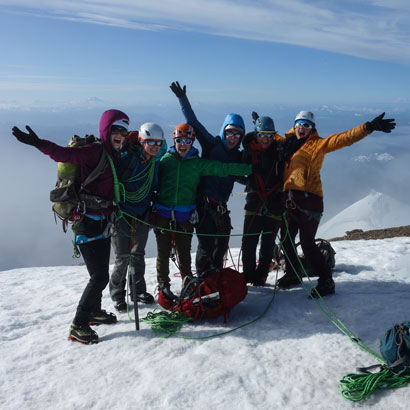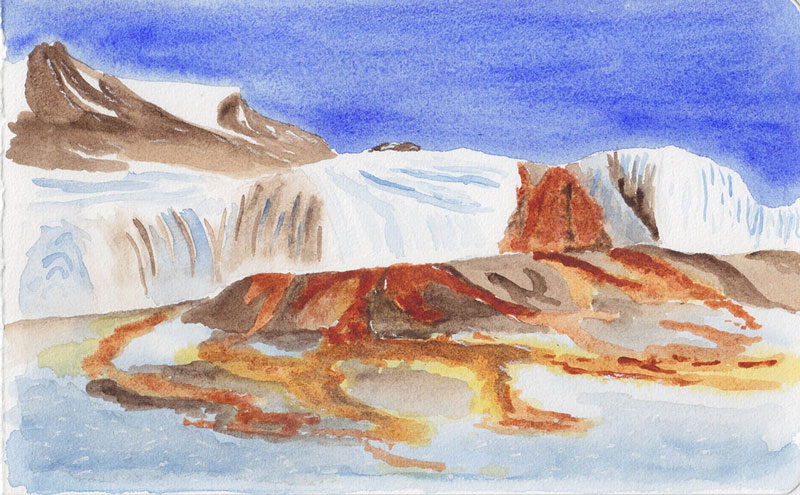Antarctica is an incredible place to do research, as glaciologist Erin Pettit knows from her 15 trips to the White Continent. But guiding energetic, scientifically curious teenagers through nature brings its own challenges and thrills. For over 20 years, Pettit, an associate professor at Oregon State University in Corvallis, has been balancing a research career with leading wilderness expeditions for young women that incorporate scientific inquiry– and art-focused experiences.
Pettit grew up in the Pacific Northwest, and her love of the outdoors developed from numerous hiking, boating, and camping trips in and around Puget Sound. Her father, an economics professor, fostered her interest in science. “He always loved doing little science fair projects with me,” said Pettit. Her mother, who studied math at a small college in Massachusetts before transferring to the University of Washington for its wider breadth of course options, inspired Pettit to work through academic challenges. “If my mom can do it, I can do it,” Pettit remembers thinking. “Even though I struggled, I knew that I could eventually do math.”
In high school, Pettit relished her math and science classes but also kept busy with sports and marching band. She enjoyed art and writing but kept those interests secret because she had trouble believing that someone interested in math and science was allowed to be creative. “I did a lot of artsy projects at home because it was always a secret love.”
Hybrid Cars to Geoscience
After graduation, Pettit headed east to Rhode Island and Brown University, where she majored in mechanical engineering. But her first job after college brought her back to the West Coast, this time to the Los Angeles area. She accepted a position as an engineer designing hybrid and electric cars, work that resonated with her personal beliefs.
“I started to realize that I needed to do something in my career that would connect with some of my values,” said Pettit. She modeled and instrumented the cars’ performance and developed algorithms to optimize how much power to draw from an engine versus a battery. “We’d drive around and collect data,” Pettit said. “It’s actually not that different from what I do now.”
But after 4 years, Pettit yearned to be more creative. “I didn’t fit well into the 9-to-5,” she said. “My brain doesn’t work in that structured of a way.” Pettit thought back to the last science class she took in college: planetary geology. The professor, Peter “Sparky” Schultz, had a knack for connecting the principles of mechanical engineering with Earth and planetary sciences, said Pettit. “How does heat flow? What happens when you fracture something? What happens if you take a meteorite and slam it into a planet? These are engineering problems.”
Library Access
Pettit’s interest in geophysics was piqued. Fortunately, her circle of friends at the time included graduate students and postdoctoral researchers at the California Institute of Technology who let her into the university’s geology library. Pettit pored over books and journals, fascinated by studies of Earth’s surface, particularly its ice-covered regions. Ice captivated her because it flowed and changed.
“I’d always been a rheology geek,” said Pettit. Studying ice “made sense with my mechanical engineering background.”
Pettit returned to her hometown of Seattle to pursue a doctorate in geophysics at the University of Washington. For her thesis, she modeled how ice flowed and applied her results to an ice dome in West Antarctica. “I wanted something that would be societally relevant,” said Pettit. “[Glaciers’] full role in the climate system wasn’t really well understood.”
Mountains for All
While in graduate school, Pettit’s long-standing interest in mentoring and supporting young people grew. “I love being in the mountains and outdoors and teaching and working with students,” she said.
With the support of the University of Washington and the North Cascades Institute, Pettit founded Girls on Ice, a program to bring young women on free, multiday expeditions focused on scientific and artistic inquiry. “I started Girls on Ice to share what I loved about exploring and going into the mountains,” said Pettit. Pettit and Michele Koppes, a glaciologist now at the University of British Columbia in Vancouver, led the first expedition in 1999 with five girls. The group hiked along Washington State’s Cascade River and then explored the South Cascade Glacier.
Girls on Ice has grown significantly since that inaugural expedition: Hundreds of young women have participated, and the program is now called Inspiring Girls Expeditions because it encompasses water- and land-focused expeditions as well as ice-based experiences. Trips are led by instructors who contribute a range of scientific, mountaineering, artistic, and communications experience.
Maria Coryell-Martin, an expeditionary artist based in Port Townsend, Wash., worked as an Inspiring Girls Expeditions instructor for three seasons. “The focus is on learning about the natural world and exploring it through science and art,” she said. “Erin is such a proponent of exploration and education.”
Bringing Science to Life
Claire Giordano, an environmental artist and writer living near Seattle, vividly remembers the Girls on Ice Cascades trip she was a part of in 2010. The 12-day expedition on Washington State’s Mount Baker was an “incredible experience,” said Giordano, who was just about to enroll in college at the time.

Prior to the trip, Giordano had planned to study psychology. But she instead went on to earn degrees in environmental studies and philosophy, a decision she attributes to her experience with Girls on Ice. “That program very specifically was a turning point in what I saw as my career options,” said Giordano.
Three instructors coled Giordano’s trip—a botanist, a mountain guide, and Erin Pettit. Giordano remembers Pettit excitedly leading the group one day to an outcropping of rocks. Pettit explained that glaciers, slowly traveling through the landscape, had left scars that were still visible. “You could see these striations in the rock where the glaciers had dug into the rock and left these huge grooves,” said Giordano. That brought science to life, she said, and she realized that science was another way to look at and understand the world.
“Erin gave all of us the gift…to see that landscape in a new way,” said Giordano.
A Glacier to Watch
When Pettit isn’t leading expeditions, she’s studying how ice in Earth’s polar regions moves, deforms, and fractures. “Ice really is alive,” Pettit, a 2013 National Geographic Emerging Explorer, said at a National Geographic–organized symposium. “It flows on our landscape.”
Pettit currently is part of an international team investigating Antarctica’s Thwaites Glacier. If this glacier collapsed, sea levels would rise by several tens of centimeters, researchers believe.
Pettit is one of two lead principal investigators of the Thwaites-Amundsen Regional Survey and Network Integrating Atmosphere-Ice-Ocean Processes (TARSAN) project, a component of the International Thwaites Glacier Collaboration. She and her colleagues are examining the stability of Thwaites’s floating ice shelf, a roughly 120-kilometer-wide swath of ice that’s being eroded from below by circulating water. This ice shelf acts as a buttress and prevents the Florida-sized glacier from flowing unimpeded into the sea.
“We’ve been watching Thwaites for a number of decades,” Pettit reported at Ocean Sciences Meeting 2020 in San Diego. “There’s a lot of feedback in the system we’re trying to get a handle on.”
The TARSAN team, which includes oceanographers, glaciologists, and meteorologists, has so far installed sensors below the ice shelf to monitor water currents, tagged elephant and Weddell seals with instruments to record ocean conditions, and steered an autonomous underwater vehicle under Thwaites’s ice shelf, said Karen Heywood, an oceanographer at the University of East Anglia in the United Kingdom and the TARSAN project’s other lead principal investigator. “Erin has been particularly good at bringing all of the elements of this project together.”
Arts and Antarctica
Pettit’s love of ice has drawn her around the world—she’s put boots on the ground in Alaska, British Columbia, Chile, Ecuador, Greenland, and Nepal. But one place stands out to her: Blood Falls, Antarctica. The striking red and orange scar near the terminus of Taylor Glacier is an eerie sight on an otherwise white landscape. After doing fieldwork there during the 2013–2014 austral summer, Pettit and her colleagues showed that Blood Falls owes its characteristic appearance to rust: Plumes of saltwater travel through the glacier, and iron contained within the brine oxidizes when it comes into contact with oxygen.
“It’s super interesting scientifically, and it’s a striking feature on the landscape,” said Pettit. She often caries a small sketchbook with her on fieldwork, and her drawing of Blood Falls captures red and orange rivulets beneath a bright blue sky.

“You’re not going to find my art in a museum anytime in the near future, but it helps me explore a place,” said Pettit. There’s actually a lot of overlap in the way scientists and artists approach something new, she said. “It’s going in with an open mind.”
In 2016, Pettit helped organize an art exhibition focused on the West Antarctic Ice Sheet Divide ice core project, which extracted a roughly 3,400-meter-long ice core, an invaluable paleoclimate record. Called Beauty to the Core, the exhibition featured paintings, mixed-media pieces, and a video installation. It debuted at the University of Alaska Museum of the North in Fairbanks before moving to Antarctica. “We wanted to bring the art out here to the place that inspired it,” Pettit said in an interview with the University of Alaska Fairbanks.
Pettit, unlike most scientists, can look at a landscape from both a research angle and an artistic viewpoint, said Coryell-Martin. She is constantly thinking about ways to share science, and Beauty to the Core is just one example of that mindset. “She’s not afraid to think outside the box and look for different ways to engage people.”
—Katherine Kornei (@Katherine Kornei), Science Writer






